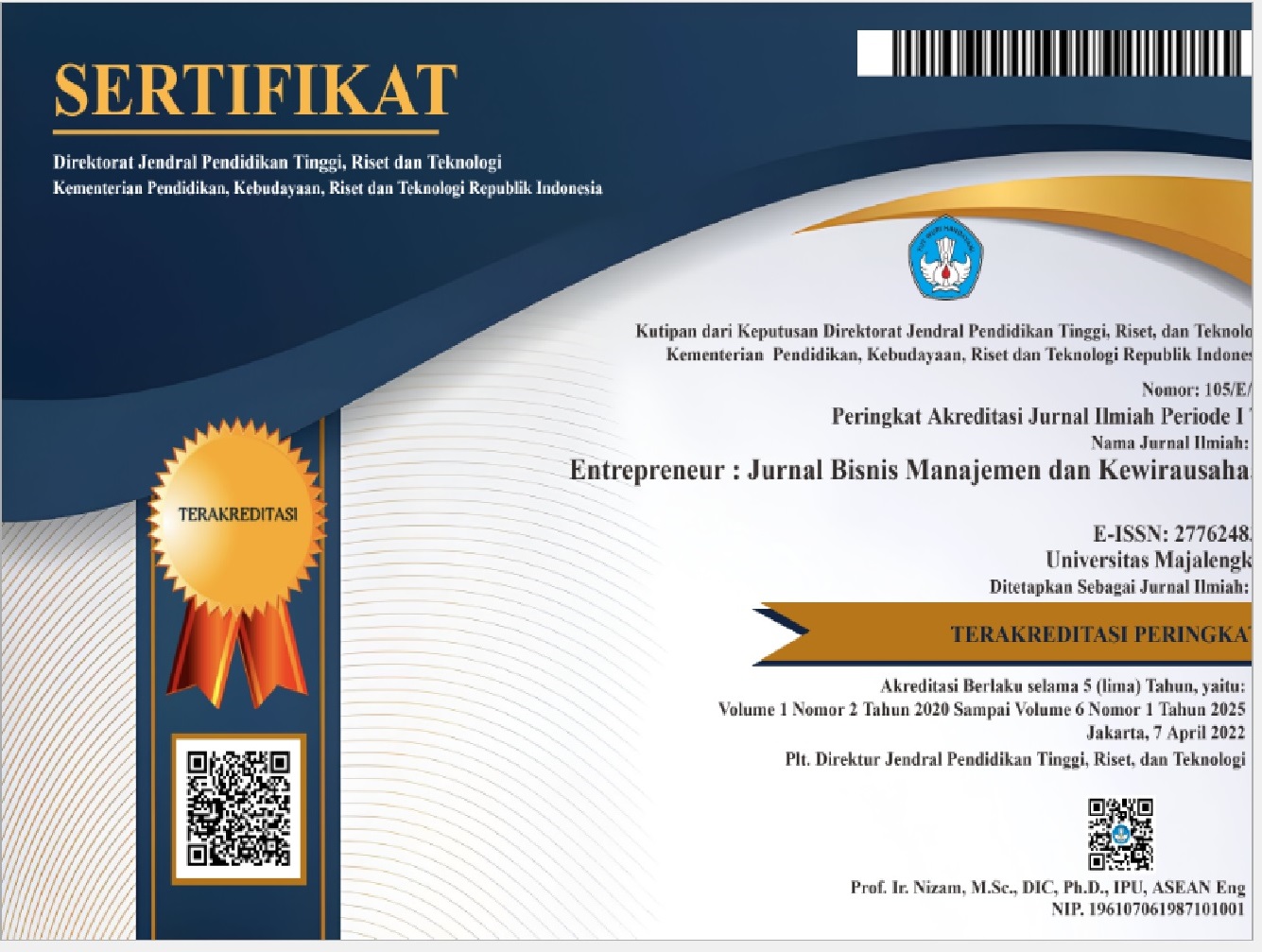DIGITAL TRANSFORMATION AND THE CUSTOMER EXPERIENCE: ENHANCING ENGAGEMENT AND LOYALTY
DOI:
https://doi.org/10.31949/entrepreneur.v4i03.6195Abstrak
This study aims to identify the most basic things in digital transformation, namely what are the factors that can improve customer experience, enhancing engagement and customer loyalty. In an effort to offer in-depth insights on this topic, this research seeks to provide direction for companies focusing on important factors in leveraging digital transformation to create a better customer experience, which in turn will increase their engagement and loyalty. To achieve this goal, this research uses a qualitative approach and case studies from existing literature with the aim of knowing what factors in digital business transformation affect customer experience in order to increase engagement and customer loyalty. This study uses purposive sampling by deep interviewing 11 active consumers from the e-commerce platform under study. Factors such as ease of use, product quality, loyalty programs, exclusive offers, responsive customer support, and special incentives and rewards are key to creating a positive experience, increasing customer engagement and strengthening their loyalty. By understanding and managing these factors, companies can create strong customer relationships, improve customer retention and increase overall business growth.
Kata Kunci:
Customer Loyalty; Customer satisfaction; Green MarketingUnduhan
Referensi
Ahdiat, Adi. (2023). https://databoks.katadata.co.id/datapublish/2023/07/07/pengunjung-shopee-dan-blibli-naik-pada-kuartal-ii-2023-e-commerce-lain-turun
Ahdiat, Adi. (2023). https://databoks.katadata.co.id/datapublish/2023/07/07/tren-pengunjung-e-commerce-semester-i-2023-shopee-kokoh-di-puncak
Andry, J. F (2018), Conceptual Framework for Successful IT-Governance and BSC for Service Industry, International Journal of Innovative Science and Research Technology, ISSN No:-2456-2165, Jakarta
Felix, A. (2018). Analisas Kinerja Suatu Perusahaan di Jakarta dengan Menggunakan Balanced Scorecard. Digismantech 1(1): 24-32.
Frasquet, M., Mollá Descals, A., & Ruiz-Molina, M. E. (2017). Understanding loyalty in multichannel retailing: the role of brand trust and brand attachment. International Journal of Retail and Distribution Management, 45(6), 608–625. https://doi.org/10.1108/IJRDM-07-2016-0118
Hadiono, K., Murti, H., & Santi, R. C. N. (2021). Artikel Transformasi Digital. Proceeding SENDIU, July, 573–578.
kominfo.go.id. (2022). https://www.kominfo.go.id/content/detail/45287/pemerintah-dorong-akselerasi-adopsi-teknologi-digital-oleh-umkm/0/berita
Morais, Duarte B. (2005). Fostering Loyal Consumer Relationships. University Park: School of Restaurant and Recreation Management.
Payne, A., & Frow, P. (2007). “A strategic framework for customer relationship management”, Journal of Marketing, 69, 167-176.
Pine, Gilmore. (2013) . https://www.researchgate.net/publication/260917972_The_experience_economy_past_present_and_future
Sarantidou, P. (2017). Enriching the ECSI model using brand strength in the retail setting. European Journal of Management and Business Economics, 26(3), 294–312. https://doi.org/10.1108/ejmbe-10-2017-017
Setiadi, Nugroho J. (2008). Perilaku Konsumen. Jakarta : Kencana
Wearesocial. (2023). https://www.slideshare.net/DataReportal/digital-2023-april-global-statshot-report-v01-april-2023
Wilujeng, F. R., Rembulan, G. D., Andreas, D., & Tannady, H. (2019). Meningkatkan Kepuasan Pelanggan pada Dua Bisnis E-Commerce Terbesar di Indonesia dengan Menggunakan Analisis Servqual dan IPA. Prosiding Semnastek.
Diterbitkan
Cara Mengutip
Terbitan
Bagian
Lisensi
Hak Cipta (c) 2023 Antonius Felix, Glisina Dwinoor Rembulan

Artikel ini berlisensiCreative Commons Attribution-ShareAlike 4.0 International License.
COPYRIGHT NOTICE
An author who publishes in the Entrepreneur: Jurnal Bisnis Manajemen dan Kewirausahaan agrees to the following terms:
1. Author retains the copyright and grants the journal the right of first publication of the work simultaneously licensed under the Creative Commons Attribution-ShareAlike 4.0 License that allows others to share the work with an acknowledgment of the work's authorship and initial publication in this journal
2. The author is able to enter into separate, additional contractual arrangements for the non-exclusive distribution of the journal's published version of the work (e.g., post it to an institutional repository or publish it in a book) with the acknowledgment of its initial publication in this journal.
3. The author is permitted and encouraged to post his/her work online (e.g., in institutional repositories or on their website) prior to and during the submission process, as it can lead to productive exchanges, as well as earlier and greater citation of the published work








